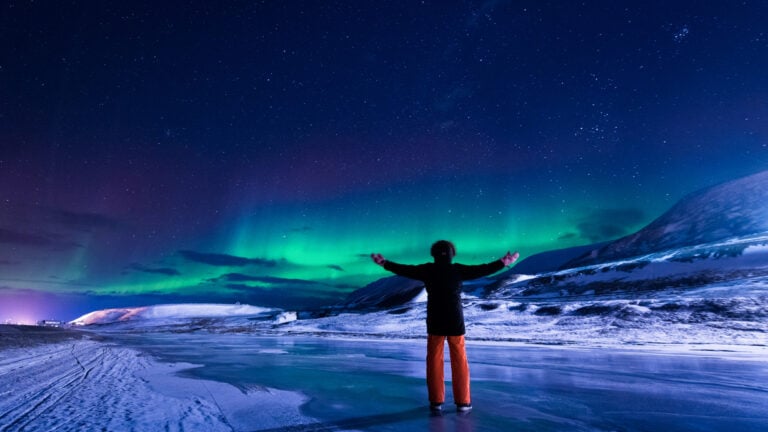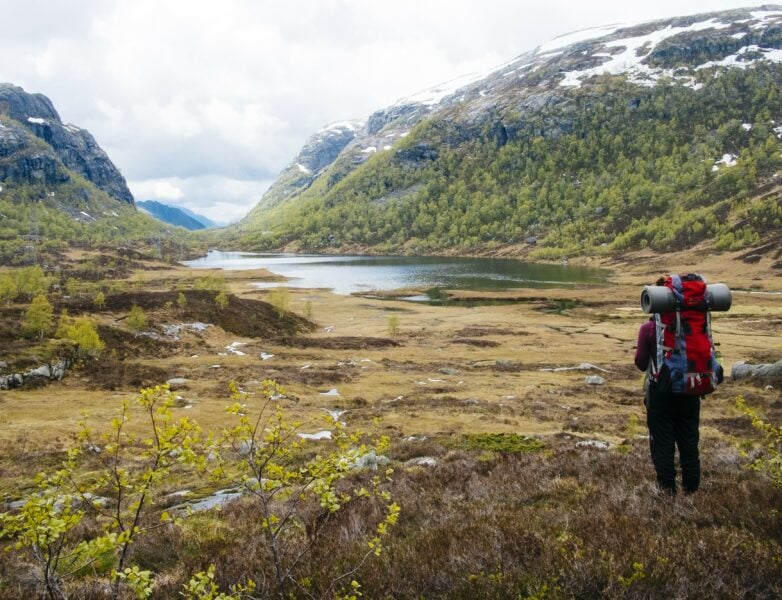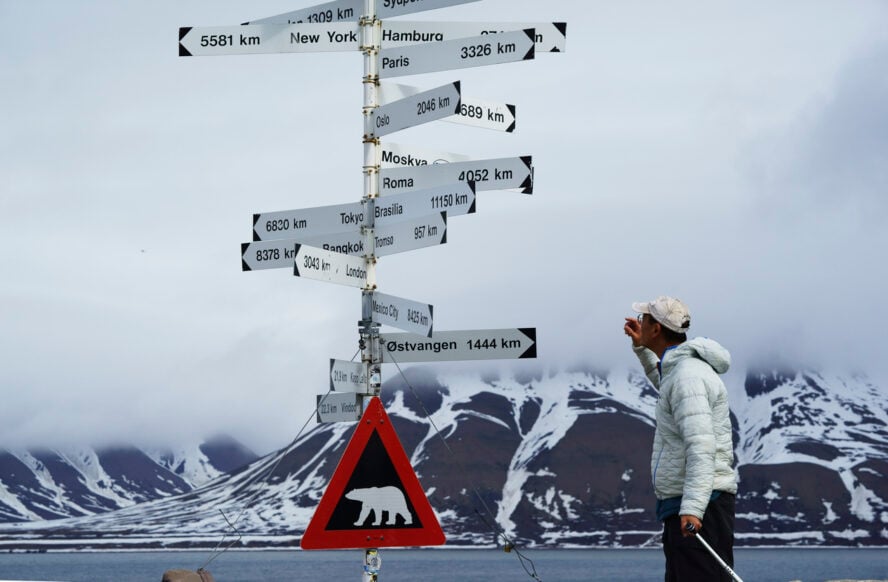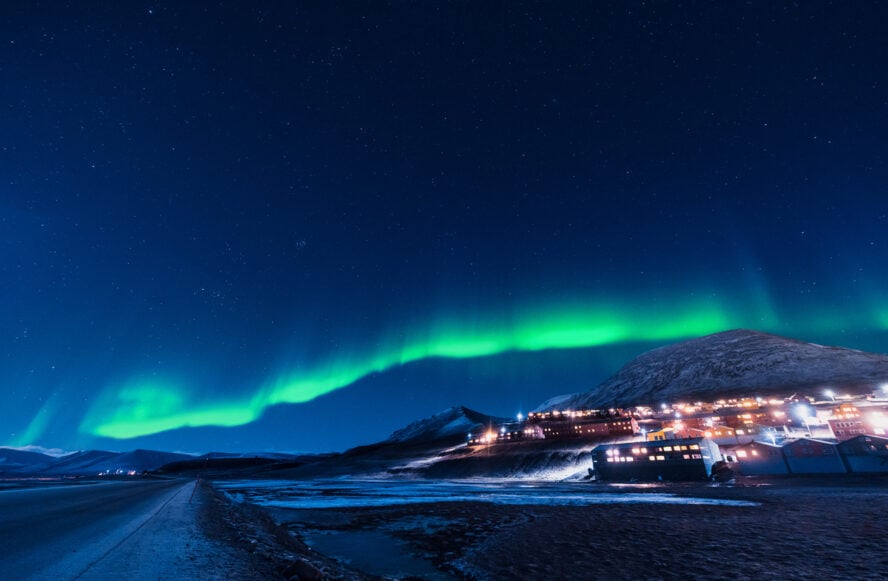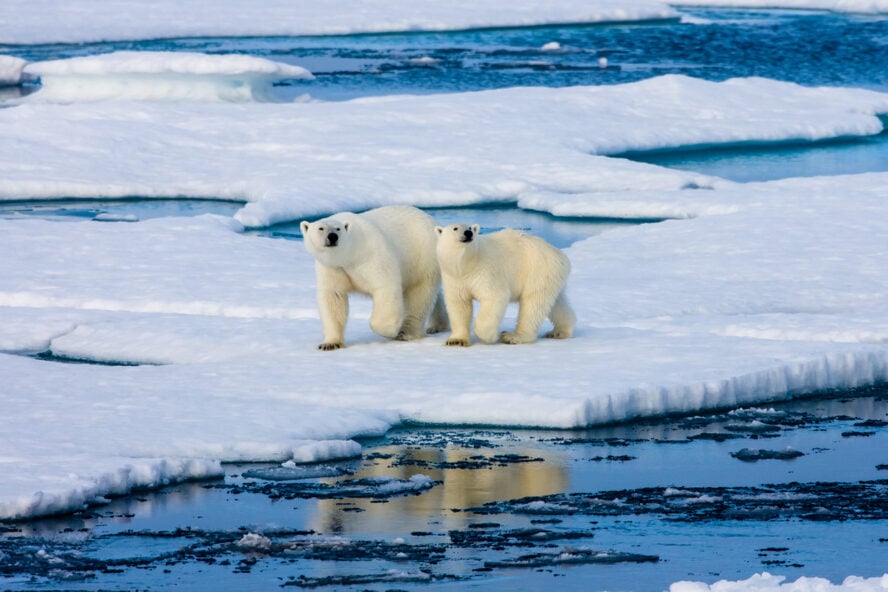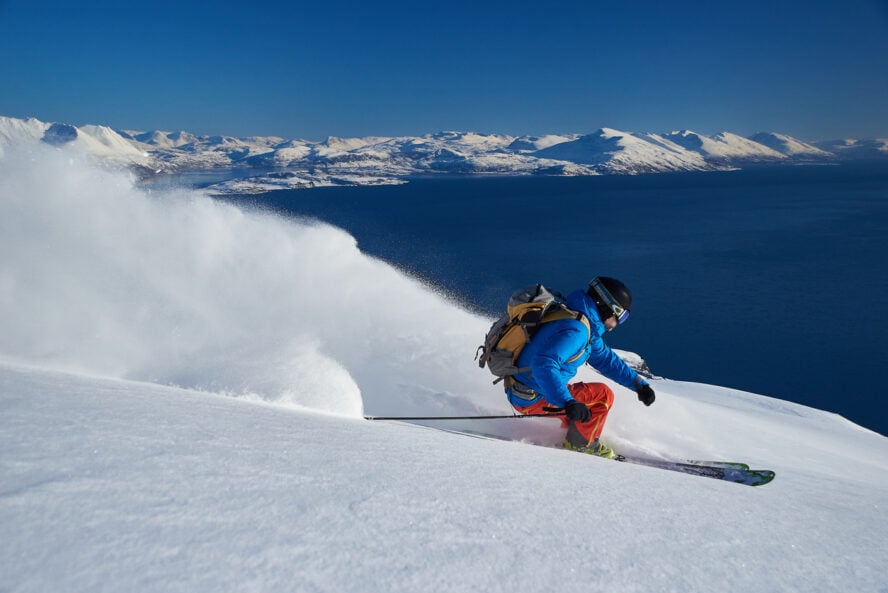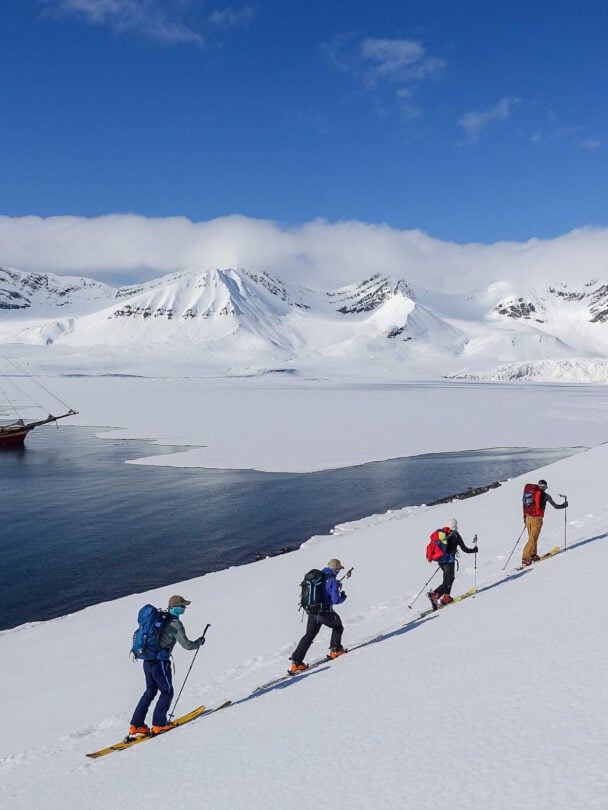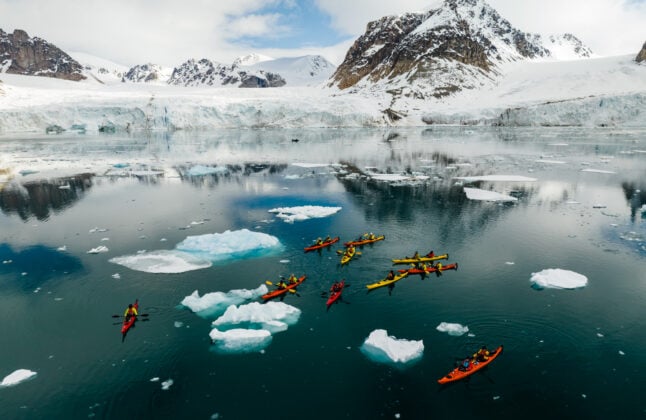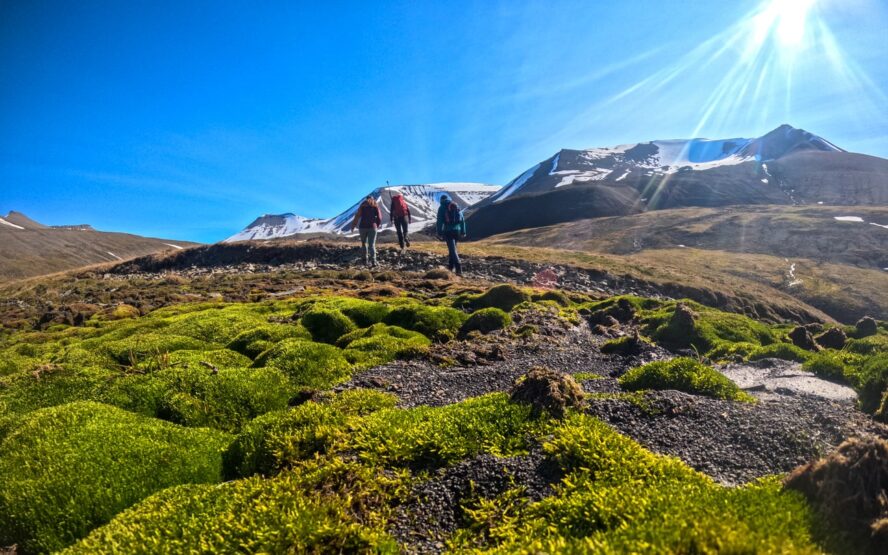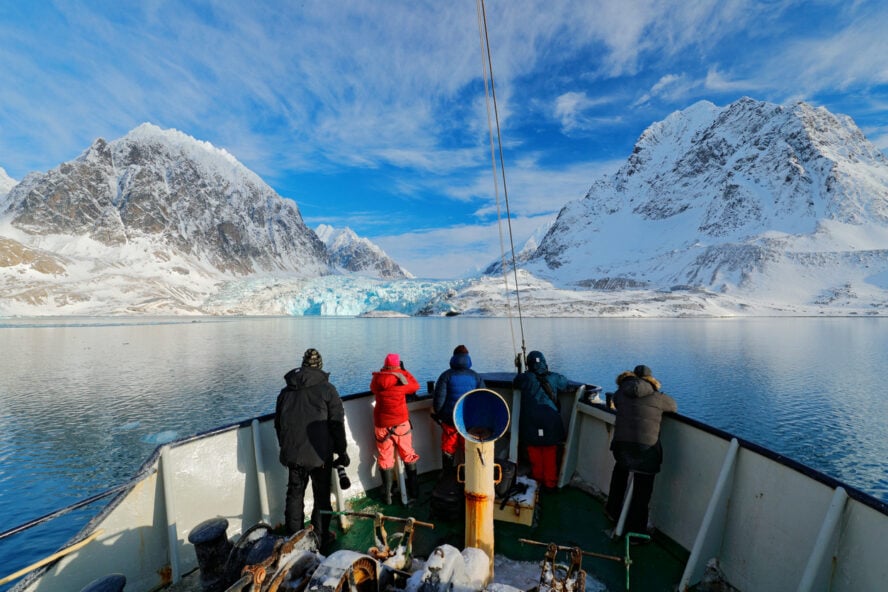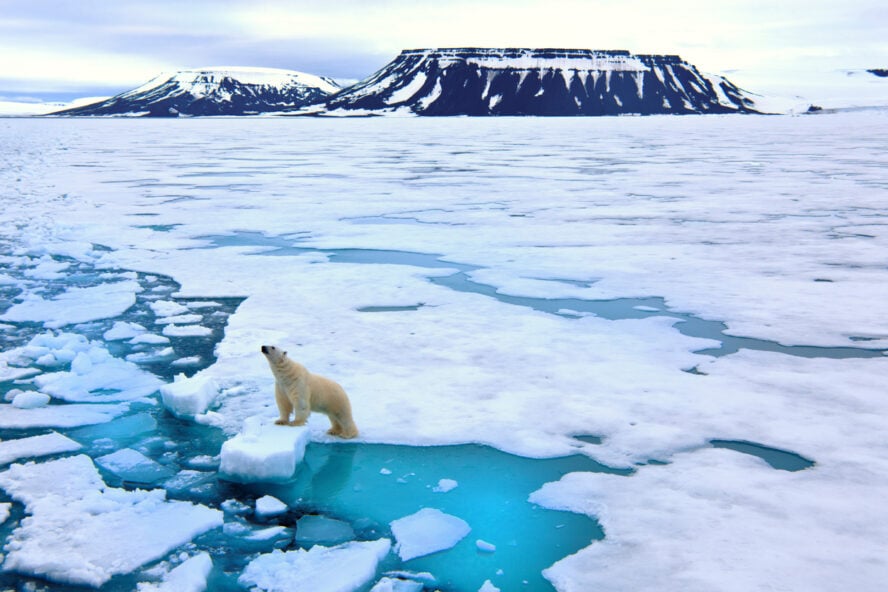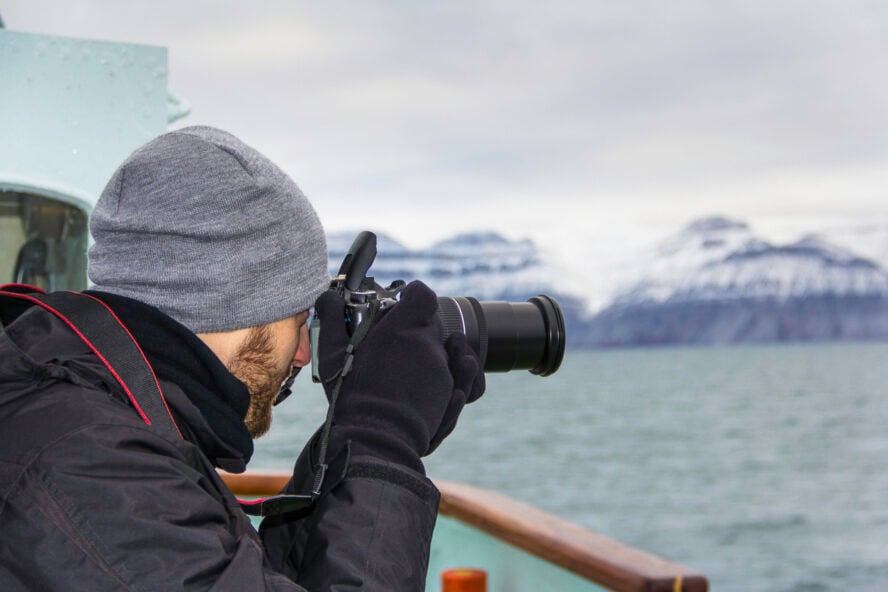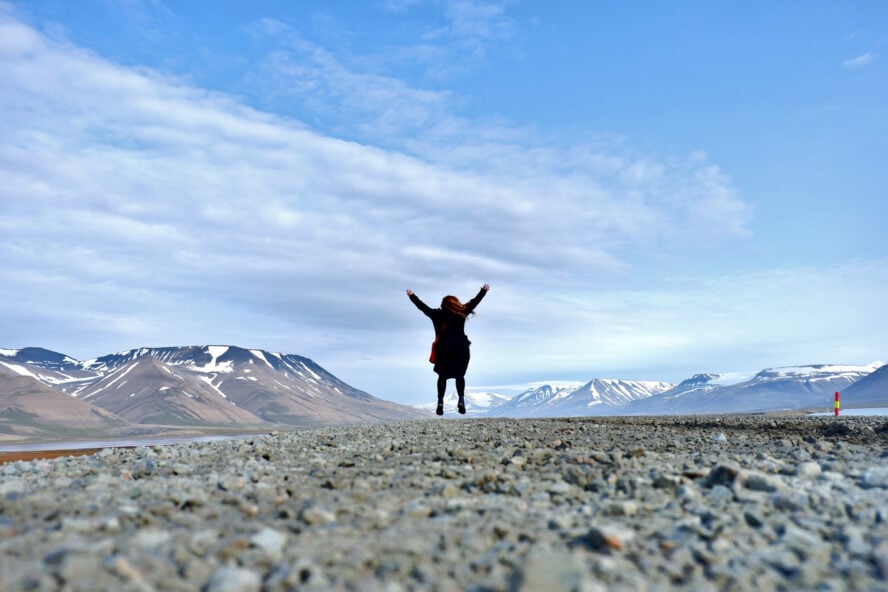Svalbard is the kind of place that grabs you by the soul and doesn’t let go.
Plunked halfway between mainland Norway and the North Pole, this Arctic archipelago is raw, wild, and unlike anywhere else. It’s where polar bears outnumber people, where the sun doesn’t set for months, and where the northern lights dance like they’re putting on a private show. But what’s the best time to visit Svalbard?
That depends on what kind of adventure you’re chasing: skiing untouched slopes, kayaking through icy fjords, spotting polar bears, or chasing the aurora. We’re gonna break it all down, based on our years of shredding powder, paddling waters, and exploring the wild.
What’s the Best Time to Visit Svalbard, Norway?
Svalbard’s seasons are extreme, and your best time to visit hinges on what you’re after. Want to ski under the midnight sun? Spring’s your jam. Chasing northern lights? Winter’s where it’s at. Polar bears? Summer’s prime.
The archipelago’s climate and light cycles are wild: 24-hour daylight from April to August and polar night from November to February, when the sun doesn’t even peek above the horizon. Each season unlocks different adventures, so here’s a cheat-sheet:
-
Visiting Svalbard in the spring (March–May): Perfect for skiing, snowmobiling, and catching the transition from polar night to endless daylight. The snow’s still deep, but the light’s coming back, making it ideal for backcountry exploration.
-
Visiting Svalbard in the summer (June–August): The midnight sun’s in full swing, and the ice melts enough for kayaking, hiking, and polar bear spotting. It’s the warmest time, with temps sometimes hitting a balmy 7°C (45°F).
-
Visiting Svalbard in the fall (September–October): A quieter season, great for hiking and kayaking before the deep freeze sets in. The northern lights start creeping back, too.
-
Visiting Svalbard in the winter (November–February): Polar night rules—total darkness, prime aurora viewing, and a surreal vibe. Snowmobiling and dog sledding are your go-to activities, but it’s cold, like -20°C (-4°F) cold.
Best time to visit Svalbard: The land of extremes
Svalbard’s seasons are like flipping a switch between two extremes. From late April to late August, the midnight sun keeps the place lit 24/7.
It’s surreal. skiing at 2 a.m., kayaking at midnight, or hiking under a sun that just won’t quit. The landscape glows, glaciers shimmer, and wildlife’s out in full force.
But it’s not just bright. It’s warm(ish), with temps between 3°C and 7°C (37°F–45°F). Perfect for exploring without freezing your face off.
Then, from late October to mid-February, you get the polar night. Total darkness. No sunrise, no sunset. Just stars, snow, and the northern lights if you’re lucky.
It’s a vibe that’s hard to describe: quiet, eerie, and magical. The aurora borealis can light up the sky in green, purple, and red waves, but you need clear skies and a bit of solar activity.
Winter’s also when Svalbard feels most remote, like you’re on another planet. Temps drop to -15°C to -20°C (5°F to -4°F), so layering up is non-negotiable. Each season transforms Svalbard into a different beast, so plan your trip around what speaks to you.
Best Time to Visit Svalbard to See Northern Lights
It’s the same deal as in Iceland. If you’re chasing the aurora, winter is your only shot. Specifically, November to February, when the polar night blankets Svalbard in 24-hour darkness. Without sunlight, the northern lights pop against the sky like neon paint. But it’s not just about chasing darkness.
When to Go
The best aurora window is mid-November to early February. Why? The skies are darkest, and solar activity peaks around the equinoxes (September and March), but Svalbard’s polar night gives you a longer viewing window than mainland Norway. Clear skies are key, so check weather forecasts for low cloud cover.
January and February often have the best combo of clear skies and cold, stable air.
Where to Watch
Longyearbyen is your base, but get away from town lights for the best views. Guided aurora tours—by snowmobile, dog sled, or even snowcat—are the way to go. They’ll take you to spots like Adventdalen or the hills around town, where the sky’s unpolluted by light. Pro tip: bundle up like you’re heading to Mars. Frostbite’s real out here.
Tips for Success
-
Check solar activity: Apps like Aurora Alerts or websites like NOAA’s Space Weather Prediction Center give you a heads-up on geomagnetic storms.
-
Layer up: Bring thermal base layers, fleece, down jackets, and windproof shells. Hand warmers are your friends.
-
Photography: A tripod and a camera with manual settings are musts. Use a wide-angle lens, high ISO (800–3200), and long exposures (5–15 seconds).
-
Patience: The aurora is a diva. She doesn’t always show. Stay out for a few hours, and don’t give up after one night.
Best Time to Visit Svalbard to See Polar Bears
Polar bears are Svalbard’s rock stars, and summer’s your best bet to spot them. From June to August, the sea ice recedes, which pushes bears closer to shorelines and makes them easier to see on boat tours or expeditions. Here’s the scoop.
When to Go
July and August are prime. The ice melt opens up fjords, letting boats reach bear hotspots like Nordaustlandet or the pack ice north of Spitsbergen. Bears hunt seals on the ice or scavenge along coasts, so you’re likely to see them prowling or lounging. Early summer (June) can work, too, but the ice is thicker, which limits boat access to many of the best spotting destinations.
Where to Look
Join a guided boat tour or multi-day Svalbard expedition cruise. Small ships (12–50 passengers) get you closer to the action than big cruise liners. Eastern Svalbard—Hinlopen Strait or Edgeøya—is where bears roam in numbers. Land-based spotting is trickier since bears avoid human settlements, and you’re legally required to carry a rifle outside town (guides handle this).
Safety and Tips
-
Guides are mandatory: Polar bears are no joke. Always go with a pro who knows the terrain and carries a rifle.
-
Binoculars: Bears can be far off, so pack a good pair (8×42 or 10×50).
-
Respect the bears: Keep your distance (200 meters minimum) and follow your guide’s rules. These are wild animals, not a zoo exhibit.
-
Book early: Summer bear tours fill up fast, especially small-group ones.
Best Time to Visit Svalbard for Skiing
Svalbard’s a skier’s paradise, but spring (March–May) is the sweet spot. The snow’s still deep, the midnight sun starts creeping in, and the temps are less brutal than winter. Here’s why it’s epic.
Best time to visit Svalbard for skiing
Late March to early May is ideal. You get 12–24 hours of daylight, perfect for long backcountry tours. The snowpack is stable, with powder in higher elevations and world-class spring corn lower down. April’s the goldilocks month. Light’s great, snow’s reliable, and it’s not too cold.
Where to ski in Svalbard
Svalbard’s backcountry is vast and untouched. Around Longyearbyen, peaks like Trollsteinen and Nordenskiöldfjellet offer everything from mellow glades to steep chutes. For multi-day trips, head to Atomfjella or the glaciers around Ny-Ålesund. Ski touring’s the name of the game. No lift-served resorts here. You’ll skin up and carve down, often with a guide due to polar bear risks.
Gear and tips
-
Ski touring setup: Lightweight skis, AT bindings, and skins are essential for all ski touring in Norway. Bring a beacon, shovel, and probe for avalanche safety.
-
Guides: Unless you’re a pro, hire a guide. They know the snowpack, routes, and bear safety.
-
Fitness: You’ll be skinning for hours, so train your legs and lungs.
-
Midnight sun bonus: Skiing at 3 a.m. under a golden sky is a bucket-list moment.
Best Time to Visit Svalbard for Kayaking
Kayaking in Svalbard is next-level. Paddling past glaciers, dodging icebergs, and maybe spotting a seal or walrus. Summer (June–August) is your window, when the fjords are ice-free and the midnight sun lights your way.
Best time to visit Svalbard for kayaking
July and August are best. The sea ice has melted enough to navigate fjords like Isfjorden or Billefjorden, and the water’s calm(ish). June can work, but you might hit more ice, limiting routes. Temps hover around 5°C (41°F), so you won’t sweat, but you won’t freeze either.
Where to kayak in Svalbard
Base yourself in Longyearbyen and join guided trips to nearby fjords. Adventfjorden’s great for beginners, with calm waters and epic glacier views. For a multi-day adventure, try Magdalenefjorden or Kongsfjorden, where you can camp on beaches and paddle past towering ice cliffs. Expedition cruises often include kayaking options, too.
Gear and tips
-
Dry suits: Mandatory. The water’s 2–4°C (35–39°F). Many tours provide them.
-
Guides: Polar bear risks mean solo kayaking’s a no-go. Stick with a pro.
-
Skills: Basic paddling experience helps, but many tours cater to beginners.
-
Wildlife bonus: You might paddle alongside seals or spot whales. Keep your camera dry!
Best Time to Visit Svalbard for On-Foot Exploration
Hiking Svalbard’s rugged terrain is like stepping into a National Geographic documentary. Summer and early fall are prime for on-foot adventures, when the snow’s gone and the tundra’s accessible.
Best time to visit Svalbard for hiking
July and August are what you’re aiming for. The ground’s mostly snow-free, and the midnight sun means you can hike whenever. September’s quieter, with crisp air and early aurora sightings, but the ground can get muddy. October’s iffy. Snow starts creeping back, and daylight is much shorter.
Where to Hike
Longyearbyen is a great hub. Try Platåberget for a half-day hike with killer views or trek to the Longyear Glacier if you’re up for a full-day mission. For multi-day trips, head to Nordenskjöld Land or the trails around Barentsburg. Guided hikes are recommended. Polar bears don’t mess around, and guides carry rifles.
Gear and Tips
-
Boots: Waterproof hiking boots with good grip. The tundra’s wet and rocky.
-
Layers: Weather changes fast. Pack a waterproof jacket, fleece, and thermals.
-
Guides: Unless you’re trained in bear safety, don’t hike solo.
-
Fitness: Trails range from easy to brutal. Know your limits.
Things You Need to Know About the Best Time to Visit Svalbard
Where is Svalbard?
Svalbard’s a Norwegian archipelago in the Arctic Ocean, about 650 miles south of the North Pole. It’s a cluster of islands—Spitsbergen’s the biggest and where most people go. Think glaciers, fjords, and mountains, with a sprinkle of human settlements like Longyearbyen. It’s remote, raw, and feels like the edge of the world.
How to Get to Svalbard
Fly into Longyearbyen, the main hub. Regular flights run from Oslo or Tromsø, Norway, on airlines like SAS or Norwegian. The trip takes about 3 hours from Oslo, and you’ll land at Svalbard Airport (LYR), one of the northernmost commercial airports. No visa’s needed for most nationalities (check Norway’s rules), but book flights early—seats sell out in peak seasons (summer and spring).
How Many People Live in Svalbard?
About 2,500 people call Svalbard home, mostly in Longyearbyen. It’s a mix of Norwegians, researchers, and adventurers from around the globe. There’s also a small Russian community in Barentsburg. Polar bears outnumber humans, with around 3,000 roaming the islands.
How Far is Svalbard from the North Pole?
Svalbard’s roughly 650 miles (1,050 km) from the North Pole. That’s close enough to feel like you’re at the top of the world but far enough to have infrastructure like hotels and bars. Expedition cruises can get you closer to the pole, but you’ll need a hefty budget.
What to Do in Svalbard
Svalbard offers a wealth of activities that go far beyond the thrill of skiing, kayaking, hiking, and wildlife spotting.
In winter and spring, you can hop on a snowmobile and tear across frozen valleys, feeling the rush of wind against your face as you navigate the stark, snowy expanses. For a more traditional Arctic experience, dog sledding is a must. There’s nothing like letting a team of eager huskies pull you through the snow.
When summer rolls in, the fjords open up for boat tours. You can cruise past towering glaciers, keep an eye out for whales breaching the surface, or spot polar bears lounging on distant shores.
If you’re curious about Svalbard’s history and culture, Longyearbyen has spots like the Svalbard Museum, which dives into the archipelago’s unique environment and past, or the North Pole Expedition Museum, a fascinating look at Arctic exploration.
For something a bit different, you can tour old coal mines, stepping into the gritty history of Svalbard’s mining days. And if you’re visiting in winter, chasing the northern lights is a bucket-list experience. Guided tours take you to prime spots under the polar night’s starry skies.
Where to Stay in Svalbard
Longyearbyen’s your main base. Options range from cozy to luxe:
-
Radisson Blu Polar Hotel: The world’s northernmost full-service hotel. Comfy, with a great bar.
-
Basecamp Hotel: Rustic-chic, with trapper-style vibes and guided day tour options.
-
Gjestehuset 102: Budget-friendly, former miners’ barracks turned guesthouse.
-
Camping: Possible in summer, but you need a guide and bear protection.
-
Barentsburg: For the most unique stay in Svalbard, go to Hotel Barentsburg in an old Russian coal mining settlement.
Book early, especially for summer and spring. Outside Longyearbyen, expedition cruises offer multi-day stays with cabins, hitting remote spots like Ny-Ålesund or the pack ice.
The best time to visit Svalbard? Depends on what you want!
Svalbard is a place that demands respect. Its weather, wildlife, and isolation aren’t for the faint-hearted. But time it right, and you’re in for a life-changing adventure.
Shredding powder, paddling fjords, or chasing the aurora, this Arctic gem delivers. Pack your gear, plan your season, and get ready for a trip that’ll stick with you forever.

